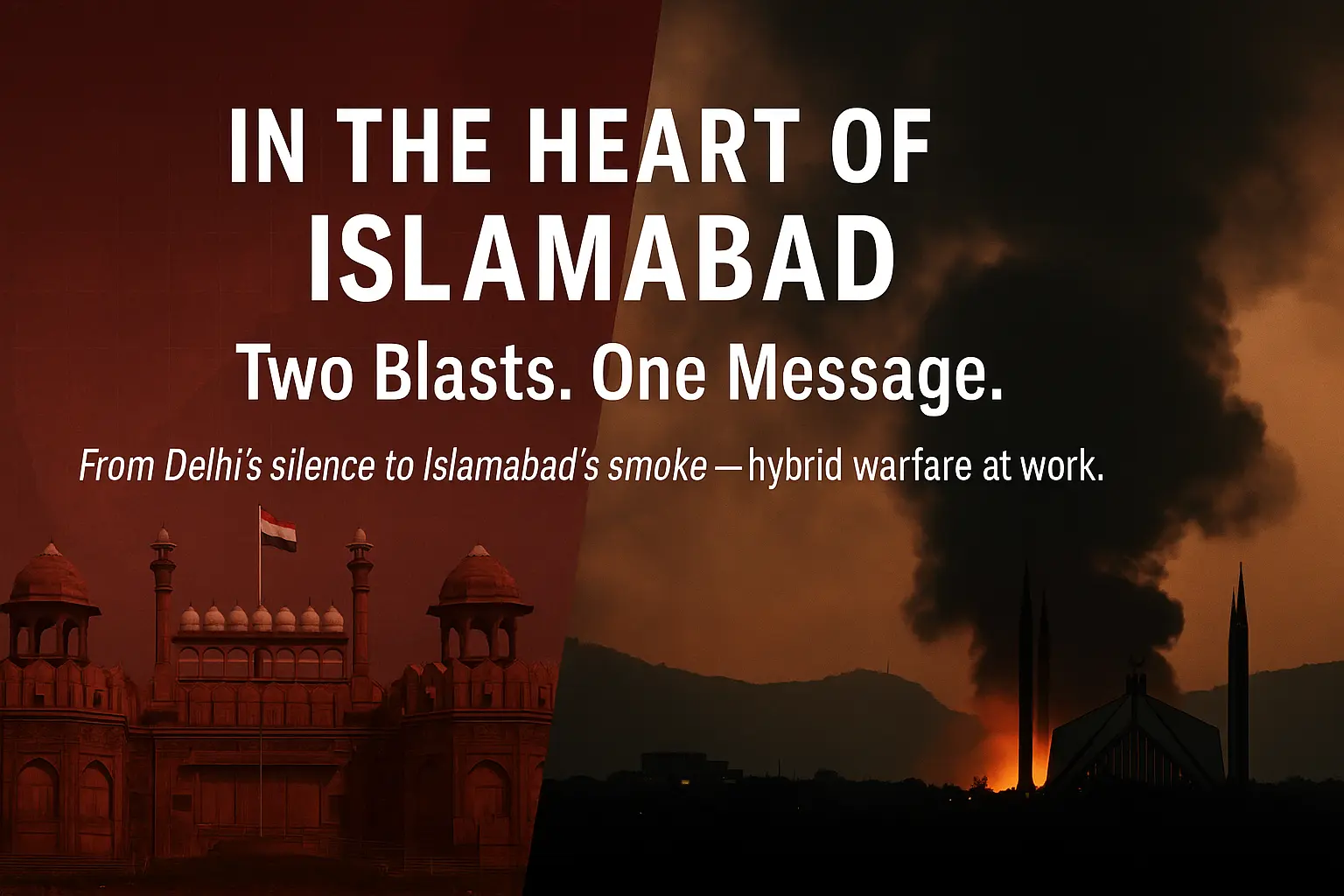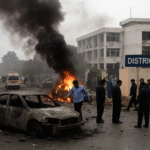Islamabad woke up on a quiet November morning to one of the most disturbing sounds imaginable — a blast echoing through the capital’s judicial heart.
A suicide bomber blew himself up outside the District Court Complex in G-11, killing twelve people and injuring many more.
The location was no coincidence. It was a message aimed at Pakistan’s state authority, law, and sense of safety.
The attack pierced the very idea of Islamabad’s security. A city built as a symbol of order and stability was jolted into the reality that terror networks remain alive, adaptive, and externally manipulated.
The Blast Before the Blast
What made this incident more alarming was its timing. Just a day earlier, an explosion had shaken the area near Delhi’s Red Fort — one of India’s most iconic national monuments.
No details were shared. No footage, no suspects, no acknowledgment from New Delhi.
Within hours, Indian media went silent. The event evaporated from the headlines as if it had never happened.
The next morning, Islamabad was burning — and the entire global press was watching.
This contrast — India’s silence versus Pakistan’s openness — is not a coincidence. It’s a calculated difference in how two neighbors control narratives during times of crisis.
The Timing: Coincidence or Coordination?
When two blasts occur in two capitals within 24 hours, it raises more than questions — it raises red flags.
Timing is a weapon in hybrid warfare, and this sequence appears too convenient to ignore.
Analysts believe the Red Fort explosion might have served as a flagged incident, a pretext or trigger for wider chaos. By staging or concealing a small-scale domestic event, adversaries can justify or synchronize broader destabilization elsewhere.
If this was indeed a coordinated signal, the Islamabad attack was not random — it was part of a larger pattern of perception warfare, aimed at shaking Pakistan’s internal stability while masking India’s own security lapses.
The Invisible Hands Behind the Scene
The claim by Jamaat-ul-Ahrar, a faction of the Tehrik-e-Taliban Pakistan (TTP), came within hours.
But behind that claim lies a darker network.
Pakistan’s intelligence and defence circles have long maintained that India’s RAW, using Afghan soil and financial conduits, has infiltrated or influenced certain TTP offshoots.
The goal: to create selective chaos inside Pakistan, particularly in the months when India faces internal political heat or border setbacks.
Whenever India struggles with Kashmir tensions, economic protests, or diplomatic embarrassments, a sudden wave of attacks surfaces inside Pakistan.
Coincidence? Hardly. It’s a pattern — one that links terrorism with political timing.
The Red Fort Silence: When Quiet Speaks Loudest
Red Fort is not just another monument. It is India’s emblem of sovereignty the site of every Independence Day address, the backdrop of power and prestige.
An explosion there, however small, is never meaningless.
India’s decision to suppress details while amplifying coverage of the Islamabad attack fits a wider information strategy:
• Keep domestic unrest hidden.
• Project Pakistan as unstable.
• Control global optics before investigations even begin.
In modern conflicts, silence is as much a weapon as sound. What India didn’t say became part of the message — a quiet deflection, shifting attention from Delhi’s vulnerability to Islamabad’s turmoil.
Hybrid Warfare in Action
The dual attacks represent more than terrorism — they demonstrate how narratives, timing, and perception can be weaponized.
Hybrid warfare blends bombs with bytes, facts with framing. It’s a war fought on TV screens, social feeds, and diplomatic corridors.
The Islamabad bombing served three purposes at once:
1. Tactical — to cause death and fear.
2. Psychological — to shatter public confidence.
3. Strategic — to let adversaries point fingers while concealing their own instability.
Meanwhile, India’s muted handling of the Red Fort explosion allowed it to control the narrative and project moral high ground, even as questions about internal security remain unanswered.
The Broader Battle: Perception Over Power
The Islamabad tragedy proves that Pakistan is fighting a two-front war — one on the ground and one in the realm of perception.
While our security forces continue to neutralize threats physically, the information battlefield remains dangerously open.
In this domain, controlling the story is as crucial as controlling the streets.
The enemy no longer needs to invade; it only needs to influence.
If Pakistan fails to seize narrative control, every act of terror will be turned into a psychological weapon — not just against the state, but against the collective morale of its people.
In the Heart of Islamabad
In the heart of Islamabad, the smoke has cleared, but the questions remain.
The blast was not just an attack it was a signal. And perhaps the silent explosion in Delhi was another, serving as its prelude.
Both events remind us that in the South Asian theatre, terrorism, politics, and propaganda now intersect.
One capital speaks through fire; the other through silence. Both are part of the same script — a psychological chess game for regional dominance.
“When bombs speak and governments go silent, the truth lies between the echoes.”
🧩 Key Takeaways
• The Islamabad suicide bombing was a symbolic strike at Pakistan’s judicial and security core.
• The Red Fort explosion in India remains unexplained and suspiciously suppressed.
• Hybrid warfare tactics — blending terror, timing, and media manipulation — are now the primary battlefield in South Asia.
• Pakistan must control both the threat and the narrative to preserve internal stability and international credibility.
Frequently Asked Questions (FAQ)
1. What happened in the Islamabad blast of November 2025?
A suicide bomber detonated outside the District Court Complex in Islamabad’s G-11 sector, killing 12 people and injuring more than 25. A faction of the TTP, Jamaat-ul-Ahrar, claimed responsibility.
2. Why is the Red Fort explosion in India linked to this incident?
The Red Fort blast occurred just a day earlier, but India provided no official details or claims. The timing and suppression of information raise questions about its possible connection or role in a coordinated information operation.
3. What is hybrid warfare in this context?
Hybrid warfare combines conventional terrorism, cyber tactics, propaganda, and information control to destabilize an adversary. In this case, the attacks and their narratives reflect a psychological campaign targeting Pakistan’s stability.
4. Is there evidence of RAW’s involvement with the TTP?
Pakistan’s intelligence agencies have repeatedly reported connections between India’s RAW and TTP factions using Afghan territory for funding and coordination. While evidence is primarily intelligence-based, the operational patterns remain consistent.
5. What does this mean for Pakistan’s national security?
The Islamabad attack highlights the need for stronger counter-terror intelligence and narrative management. Pakistan must secure both its physical defenses and information domain to counter evolving hybrid threats.
Final Thought
The explosion in Islamabad wasn’t just a tragedy it was a message, timed and amplified to shake Pakistan’s confidence and credibility.
And the silence surrounding Delhi’s Red Fort wasn’t peace it was strategy, designed to manipulate perception and shift blame.
South Asia’s wars are no longer fought only with missiles they’re fought with memories, media, and manipulation.
And in this war of narratives, Pakistan must ensure its voice is the loudest and the clearest.










